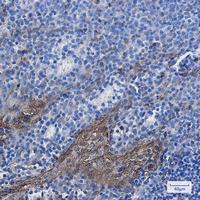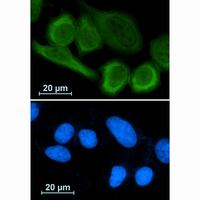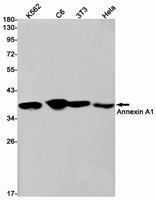| Cat.#: N261844 |
| Product Name: Anti-Annexin A1 Rabbit Monoclonal Antibody |
| Synonyms: ANXA1; ANX1; LPC1; Annexin A1; Annexin I; Annexin-1; Calpactin II; Calpactin-2; Chromobindin-9; Lipocortin I; Phospholipase A2 inhibitory protein; p35 |
| UNIPROT ID: P04083 |
| Background: Plays important roles in the innate immune response as effector of glucocorticoid-mediated responses and regulator of the inflammatory process. Has anti-inflammatory activity (PubMed:8425544). Plays a role in glucocorticoid-mediated down-regulation of the early phase of the inflammatory response . Promotes resolution of inflammation and wound healing (PubMed:25664854). Functions at least in part by activating the formyl peptide receptors and downstream signaling cascades (PubMed:15187149, PubMed:25664854). Promotes chemotaxis of granulocytes and monocytes via activation of the formyl peptide receptors (PubMed:15187149). Contributes to the adaptive immune response by enhancing signaling cascades that are triggered by T-cell activation, regulates differentiation and proliferation of activated T-cells (PubMed:17008549). Promotes the differentiation of T-cells into Th1 cells and negatively regulates differentiation into Th2 cells (PubMed:17008549). Has no effect on unstimulated T cells (PubMed:17008549). Promotes rearrangement of the actin cytoskeleton, cell polarization and cell migration (PubMed:15187149). Negatively regulates hormone exocytosis via activation of the formyl peptide receptors and reorganization of the actin cytoskeleton (PubMed:19625660). Has high affinity for Ca2+ and can bind up to eight Ca2+ ions . Displays Ca2+-dependent binding to phospholipid membranes (PubMed:2532504, PubMed:8557678). Plays a role in the formation of phagocytic cups and phagosomes. Plays a role in phagocytosis by mediating the Ca2+-dependent interaction between phagosomes and the actin cytoskeleton . |
| Immunogen: Recombinant protein of human Annexin A1 |
| Applications: WB,IHC-F,IHC-P,ICC/IF,IP |
| Recommended Dilutions: WB: 1/500-1/1000 IHC: 1/50-1/100 IF: 1/50-1/200 IP: 1/20 |
| Host Species: Rabbit |
| Clonality: Rabbit Monoclonal |
| Clone ID: R08-5A8 |
| MW: Calculated MW: 39 kDa; Observed MW: 39 kDa |
| Isotype: IgG |
| Purification: Affinity Purified |
| Species Reactivity: Human,Mouse,Rat |
| Conjugation: Unconjugated |
| Modification: Unmodified |
| Constituents: PBS (without Mg2+ and Ca2+), pH 7.3 containing 50% glycerol, 0.5% BSA and 0.02% sodium azide |
| Research Areas: Signal Transduction |
| Storage & Shipping: Store at -20°C. Avoid repeated freezing and thawing |

Immunohistochemistry analysis of paraffin-embedded Human tonsil using Annexin A1 antibody. High-pressure and temperature Sodium Citrate pH 6.0 was used for antigen retrieval. | 
Immunocytochemistry analysis of Annexin A1 (green) in A549 using Annexin A1 antibody,and DAPI(blue). | 
Western blot analysis of Annexin A1 in K562, C6, 3T3, Hela lysates using Annexin A1 antibody. | |
|













